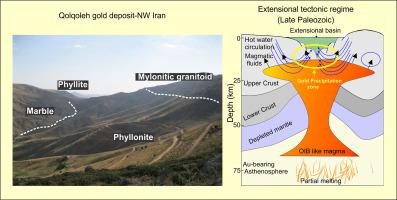Lithos ( IF 2.9 ) Pub Date : 2021-01-07 , DOI: 10.1016/j.lithos.2021.105974 Narges Daneshvar , Mohammad Maanijou , Hossein Azizi , David R. Lentz , Chris R.M. McFarlane

|
A few gold deposits occur in northwest Iran which are hosted by mylonitic granitoids and phyllonite. New U--Pb ages yield ages of 350–311 Ma for the mylonitic granitoid and 354–348 Ma for the phyllonite, which indicate Carboniferous magmatic activity in northwest Iran. The host granitoid and phyllonite have high contents of Zr (212, 246 ppm) and Y (26.8, 38.7 ppm). High 10,000 × Ga/Al ratios (2.1–5.1) and fractionation of the rare earth elements (REEs) pattern with depletion of Eu, Sr, and P may infer an A-type (anorogenic) granite affinity for the host rocks. Correspondingly, these rocks are characterized by high contents of Nb (33.1 to 39.2 ppm), Ta (1.68 to 2.40 ppm), Tb (0.84 to 1.17 ppm), and Th/Yb ratios with some similarity to OIB-like rocks. Whole rock compositions of these host rocks are consistent with both A1 and A2 type granites, which infer magmatic activity in an extensional tectonic regime. Perhaps the extension may have occurred during rifting of Neo-Tethys in northern Gondwana. Upwelling of the hot OIB-like melts during the opening of Neo-Tethys ocean was the main mechanism of this extension. The OIB signatures of the A-type granitoids controlled the gold mineralization during this process. Accordingly, we classify the gold mineralization in NW Iran as intrusion-related gold deposits. These mantle-derived magmas from the asthenosphere may support a source of both sulfur and gold. These elements were concentrated in hydrothermal fluids in the late stages of magma crystallization. Also, hot magma injection increased the geothermal gradient and caused extensive dehydration of the sedimentary rocks inin the roof of the magma chamber. Circulation of these hot fluids with injection into the hot crystallizing magmatic rocks and mixing with late-stage magmatic-hydrothermal fluids and meteoric water (?) seem to all have essential roles for transporting the gold and precipitating it within fractures in the semi-brittle to brittle zone. The gold precipitated as native or nanoparticles in pyrite in the inner part of the shear zone. This research reveals that mineralization occurred in the Late Paleozoic in an extensional tectonic regime and not above the subduction zone or collision zone which had been suggested before.
中文翻译:

伊朗西北部含金的锆石U-Pb年龄是石炭纪而不是新生代时代金矿化的证据!
在伊朗西北部,有一些金矿床,这些矿床是由lon质花岗岩和辉绿岩构成的。新的U–Pb年龄为镁铁质花岗岩类,年龄为350–311 Ma,钙钛矿为354–348 Ma,表明伊朗西北部的石炭纪岩浆活动。主体花岗岩和钙钛矿具有较高的Zr(212,246 ppm)和Y(26.8,38.7 ppm)含量。10,000×Ga / Al高比率(2.1–5.1)以及稀土元素(REEs)模式的分馏以及Eu,Sr和P的消耗可能推断出A型(人造)花岗岩对基岩的亲和力。相应地,这些岩石的特征是高含量的Nb(33.1至39.2 ppm),Ta(1.68至2.40 ppm),Tb(0.84至1.17 ppm)和Th / Yb比,与OIB类岩石有些相似。这些主岩的整体岩石成分与A 1一致和A 2型花岗岩,可在伸展构造条件下推断岩浆活动。延伸可能是在冈瓦纳北部新特提斯裂谷期间发生的。在新特提斯洋开放期间,像OIB一样的热熔体上升是这种扩展的主要机制。在此过程中,A型花岗岩的OIB签名控制了金矿化。因此,我们将伊朗西北部的金矿化归类为与入侵有关的金矿床。这些来自软流圈的地幔衍生岩浆可能支持硫和金的来源。这些元素在岩浆结晶的后期集中在热液中。另外,热岩浆注入增加了地热梯度,并导致岩浆室顶部内的沉积岩大量脱水。注入热结晶岩浆岩中并与后期岩浆热液和陨石水混合的这些热流体的循环,似乎对将金输送并在半脆性裂缝中将金沉淀在裂缝中起着至关重要的作用。脆性区。金在剪切区内部以黄铁矿形式沉淀为天然或纳米颗粒。这项研究表明,成矿作用发生在古生代晚期,处于伸展构造条件下,而不是在以前认为的俯冲带或碰撞带之上。











































 京公网安备 11010802027423号
京公网安备 11010802027423号